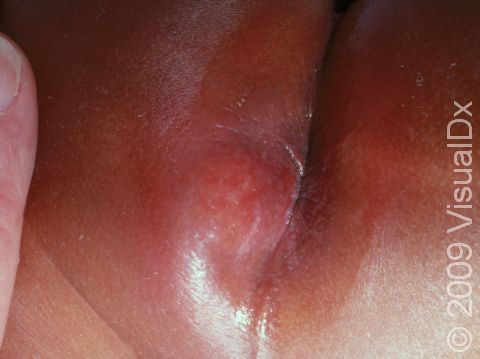Abscess
An abscess is an infection characterized by a collection of pus underneath a portion of the skin. Bacteria commonly causing abscesses are Staphylococcus aureus and Streptococcus. These bacteria enter the skin through any cracks or injury to the skin. That area of skin then becomes red, tender, warm, and swollen over days to 1–2 weeks and a fever may develop. Abscesses can sometimes form if minor superficial skin infections are not treated appropriately and in a timely fashion. Most abscesses resolve quickly once appropriately treated.
Community-associated methicillin-resistant Staphylococcus aureus (CA-MRSA) is a strain of “staph” bacteria resistant to antibiotics in the penicillin family, which have been the cornerstone of antibiotic therapy for staph and skin infections for decades. CA-MRSA previously infected only small segments of the population, such as health care workers and persons using injection drugs. However, CA-MRSA is now a common cause of skin infections in the general population. While CA-MRSA bacteria are resistant to penicillin and penicillin-related antibiotics, most staph infections with CA-MRSA can be easily treated by health care practitioners using local skin care and commonly available non-penicillin-family antibiotics. Rarely, CA-MRSA can cause serious skin and soft tissue (deeper) infections. Staph infections typically start as small red bumps or pus-filled bumps, which can rapidly turn into deep, painful sores. If you see a red bump or pus-filled bump on the skin that is worsening or showing any signs of infection (ie, the area becomes increasingly painful, red, or swollen), see your doctor right away. Many patients believe incorrectly that these bumps are the result of a spider bite when they arrive at the doctor’s office. Your doctor may need to test (culture) infected skin for MRSA before starting antibiotics. If you have a skin problem that resembles a CA-MRSA infection or a culture that is positive for MRSA, your doctor may need to provide local skin care and prescribe oral antibiotics. To prevent spread of infection to others, infected wounds, hands, and other exposed body areas should be kept clean and wounds should be covered during therapy.
Factors that predispose individuals to developing an abscess include:
- Any skin infection, especially those that are untreated
- Weakened immune system due to underlying illness or medication
Who's At Risk?
Abscesses can occur in anyone and occur anywhere on the body.
You might be able to sense fluid in an abscess when you press on the abscess with a finger.
Signs & Symptoms
A worsening red, tender swelling that arises over a period of 1–2 weeks. The pus underneath the skin is usually not visible. Your child may have a fever or a general sense of not feeling well.
Self-Care Guidelines
There are no self-care options for abscesses. While waiting to see your child’s doctor, you can try applying a warm compress to the affected area and give him or her ibuprofen (in infants older than 2 months) to help with the swelling and pain.
Treatments
Your child’s doctor may drain the pus or fluid collection by making a small incision in the skin after it has been numbed. While this can be scary and difficult for you and your child, it will drain a majority of the bacteria, helping the body fight the small amount that remains. This fluid may then be sent to a laboratory for testing (culture), but not necessarily. The culture can tell the doctor not only what type of bacterium is causing the infection but also what antibiotics will work best to treat it. This may take as little as 2–3 days, and your doctor may choose to have your child start oral antibiotics aimed at treating the most common bacteria that cause abscesses. However, if the infection is small and it has been drained, your doctor may decide to not treat your child with oral antibiotics.
If your child’s symptoms are not improving or it is determined that the bacterium is not one of the common types, your doctor may prescribe different antibiotics. If the doctor prescribes antibiotics, it is important for your child to take the entire course as prescribed, even if he or she is feeling better or the infection appears to be gone after just a few days. Since this can be difficult with infants, your pharmacist may recommend flavoring the medication. If your child has been taking antibiotics and the infection itself or the way he or she is generally feeling has not improved in about 2–3 days, return to see the doctor.
Visit Urgency
A worsening red, tender swelling should prompt you to make an appointment with your child’s physician as soon as possible. If the area involves the child’s face, spreads very rapidly, or is in an area that severely limits his or her functionality, you should seek emergency care for the child.
References
Bolognia, Jean L., ed. Dermatology, p. 1126. New York: Mosby, 2003.
Wolff, Klaus, ed. Fitzpatrick’s Dermatology in General Medicine. 7th ed, pp. 874, 1702. New York: McGraw-Hill, 2008.
Last modified on October 10th, 2022 at 8:32 pm

Not sure what to look for?
Try our new Rash and Skin Condition Finder
